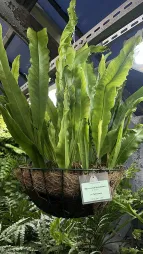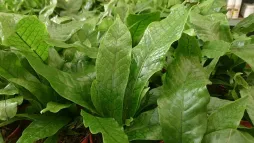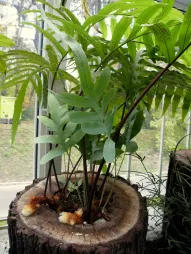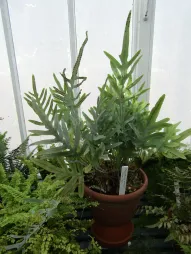Microsorum punctatum 'Grandiceps', the other fishtail fern
When we think of fishtail fern, we often think of Nephrolepis falcata. But for our Anglo-Saxon friends, there's another fishtail fern: Microsorum punctatum 'Grandiceps'. This cultivar also boasts fronds worthy of the Little Mermaid.
How to recognize Microsorum punctatum 'Grandiceps'?
An epiphytic fern with a bushy growth habit, Microsorum punctatum 'Grandiceps' doesn't exceed 60 cm in all directions.
The plant has no stem. Its evergreen foliage grows from a short, scale-covered underground rhizome.
Microsorum punctatum 'Grandiceps' is easy to recognize at a glance. Its green fronds are shiny and leathery, with wavy, entire margins. But whereas microsorum punctatum has lanceolate leaves, those of the 'Grandiceps' cultivar are multi-furrowed. At the base, they are ribbon-shaped. But they divide at the apex to form ridges. It's this characteristic that earns it the nickname "fishtail fern".
Plants in the Polypodiaceae family multiply by spores. In Microsorum punctatum, these are grouped together on the underside of leaves in brown sporangia.
Microsorum punctatum 'Grandiceps' is not a toxic plant. You can add it to your collection without fear, even if you live with young children or pets. Nor do you need to wear gloves when repotting and pruning.
Our maintenance tips
Microsorum punctatum 'Grandiceps have a reputation for being easy to care for. This is true, provided they are given a high level of humidity and very regular watering.
Watering
Allow the rootball to dry out to one centimeter between waterings. Water generously with non-calcareous water (rainwater, for example) at room temperature.
Drain off any excess water left in the dish or planter. It can rot the roots.
Repotting
In spring, transfer your Microsorum punctatum 'Grandiceps' to a larger pot, so that it can continue to grow.
Obtain a pierced pot of a larger size than the previous one. You can choose a terracotta container. Heavier, it will prevent your Microsorum punctatum 'Grandiceps from tipping over.
Fill the pot with a light, draining substrate. You can use potting soil for orchids or potting soil for green plants with peat, perlite and coconut fibre.
Plant microsorum punctatum 'Grandiceps in the center and add substrate. Do not bury rhizomes deeply. Water to facilitate rooting.
Place the pot on a saucer of moist clay balls to increase humidity.
Fertilization
You can stimulate the development of your plant during its growth phase, in spring and summer, with fertilizer.
Fertilize your Microsorum punctatum 'Grandiceps with a green plant fertilizer to support growth. Remember to halve the dose prescribed by the manufacturer.
Prune
To encourage the growth of your Microsorum punctatum 'Grandiceps, prune regularly.
There's no need to prune the foliage. Remove only dry fronds with clean, sharp pruning shears.
Cutting
Cutting is carried out during the strong growth phase, generally in spring and early summer.
Locate a rhizome with one or two fronds. Cut it with clean, sharp secateurs.
Prepare a pierced pot. Fill it with a light, well-draining substrate. You can choose orchid potting soil, for example, or make up your own mix of potting soil for green plants, peat moss, coconut fibre and perlite.
Plant your cutting without burying the rhizome deeply. Water to facilitate rooting.
Place the pot on a dish of moist clay balls to increase humidity.
Disease / Threat
Information
| Family | Polypodiaceae - Polypodiaceae |
| Type | Microsorum - Microsorum |
| Species | Microsore punctata - Microsorum punctatum |
| Lifecycle | Perennial |
| Foliage | Evergreen |
| Exposure | |
| Substrat | |
| Planting method |
In pots |
| Categories | |
| Tag |
Fritillary |
| Origins |
West Africa Southeast Asia Oceania Australia |
| Hardiness (USDA) | 9b |
| Leaf color |
|
Discover plants from the same family

Microsorum punctatum
Discover

Alligator fern
Discover

Golden polypod
Discover

Phlebodium aureum 'Blue Star
Discover
















